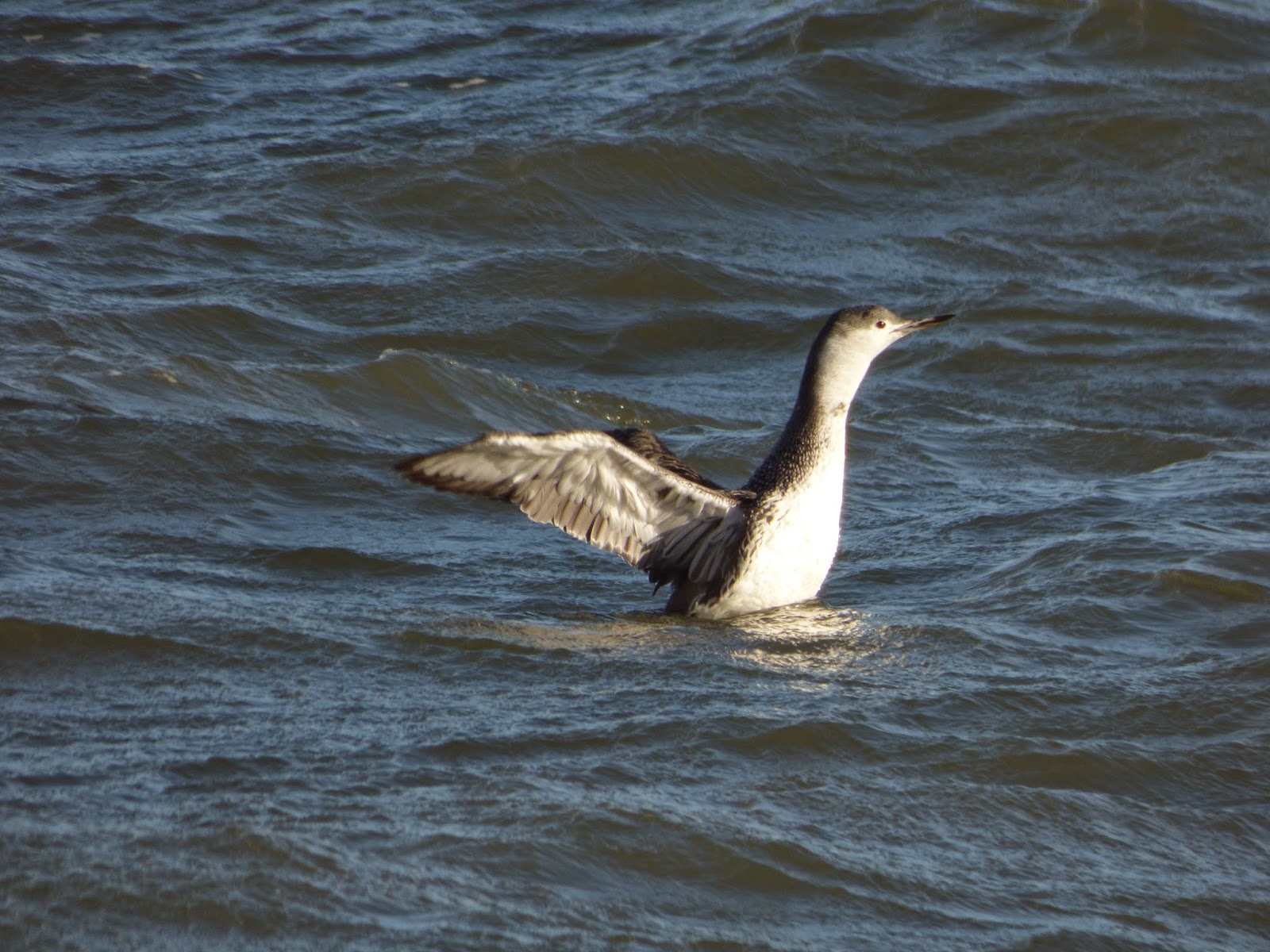Comencé el día echando un vistazo al río y dsifrutande de las siempre presentes serretas grandes. ¡Qué bichos tan bonitos. No puedo esperar a verlos en plumaje nupcial! Hoy conseguí hacerles alguna foto y un mejor video que el anterior.
Una vez en la playa encuentro varios grupos de aves posadas en el mar, pero bastante lejos. Son grupos mixtos de eiders, serretas grandes, serretas medianas y gaviotas, pero al mirar con más atención encuentro unas 10 aves bastantes más pequeñas. Resultan ser preciosas haveldas! A lo largo de la playa vi un total de 30 y, entre ellas, algún precioso macho.
Las fotos son testimoniales porque el oleaje y la distancia hacían imposible hacer una foto decente.
Parece mentira que estas aves tan pequeñas pasen el invierno entero en el mar, a merced del oleaje y de temporales. Llevaba cuatro años sin ver un havleda y esta es la primera vez que veo un macho en plumaje nupcial. Espero que sea la primera de muchas observaciones.
Mientras esperamos a los escribanos lapones y nivales, los bisbitas costeros nos hacen compañía.
La nota negativa de hoy ha sido encontrar dos focas muertas en la playa, pero el ciclo de la vida es así y el mar del norte es mucho mar del norte!
Para no terminar esta entrada con algo negativo os muestro a los otros portagonistas del día, los colimbos chicos. Hoy eran especialmente numerosos (50+) y algunos se acercaron los suficiente para hacerles alguna foto.
English translation of the text:
LONG-TAILED DUCKS AND DIVERS AHOY!
The weather’s still pretty grim on the east coast of Scotland;
not much rain but a hell of a lot of wind. Today I went back to Aberdeen beach.
Despite the poor weather it’s just as lively as usual, perhaps even more so.
Winter species are starting to arrive and the sea is boiling with life.
I started the visit with a quick look at the more sheltered
river estuary, enjoying the ever-present goosanders. What beautiful birds they are!
I can’t wait to see them in summer plumage! Today I managed to get a couple of
snaps and a better video than on the previous visit.
Once on the beach I saw several rafts of seabirds far out on
the sea. They were mixed flocks of eiders, goosanders, red-breasted mergansers
and gulls. A closer look, however, showed up a group of about 10 smaller birds.
Turned out they were long-tailed ducks! Along the beach I found about 30 in all,
some gorgeous drakes among them.
The photos are just for the record because the wind, swell,
surf and distance made it impossible to get any decent photo.
It’s incredible to think that birds this small spend the
whole winter on the sea, at the mercy of waves and storms. It’s been four years
since I saw my last long-tailed duck and this is the first time I’ve ever seen
a drake in summer plumage. I hope it’s the first of many future sightings.
While waiting for the first Lapland buntings and snow
buntings to arrive, the rock pipits keep us company along the beach.
The down note of today was to find two dead seals on the
beach. But life is tough at times for these lovely creatures, especially on the
North Sea when the tail end of a hurricane has just passed through.
To end on a more upbeat note, I’ll wind up with some photos
of the red-throated divers. Today they were especially numerous (50+) and some
came close enough for a photo.















Bonitas aves Sam; a ver si tenéis algún día con buen tiempo para que puedas sacar partido de la cámara y nos enseñes más especies de la zona.
ResponderEliminarUn abrazo.
Gracias Según!
EliminarEsto en ello. Después de las navidades, con mi réflex en ristra, espero que mejoren un poco la calidad de las fotos
Abrazos
Sam
De seguro que el tiempo mejorará y te aclimatarás pronto a las condiciones del mar del Norte. también estoy seguro que le tomarás la mano al comportamiento de las aves y lograrás muchas fotos más. Me gustan esas serretas, por estas latitudes representados por una especie muy amenzada que vive en la selva Paranense
ResponderEliminarEspero ver más fotos de aves de esas regiones, estas bastante diferentes a las que tengo vistas
Saludos
Madre mía, ¡cómo me gustaría ver esta serreta selvática! Tiene que ser el no va más. Muchas gracias como siempre por la visita, Hernán.
EliminarAbrazos
Sam
Ni un huracán te impide tu salida de los sábados, para poder conocer y enseñarnos la naturaleza de esas tierras del norte.
ResponderEliminarUn fuerte abrazo
Bueno, quizás un huracán me impide, pero aquí si no sales con viento no sales.
EliminarAbrazos desde lejos, Alex
Joder que envidia!!!!!!!!
ResponderEliminarLa verdad que es un paraíso para un español pajarero.
Seguiremos el blog y cuando esté en casa te enlazo.
Saludos y a cuidarse.
Bienvenido Fernando!
ResponderEliminarMuchas gracias por la visita y el enlace
Saludos
Sam